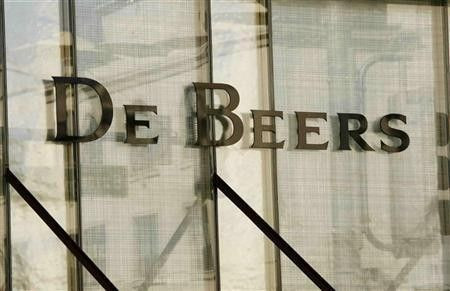De Beers sees 2011 diamond price growth shy of 2010

Rough diamond prices are expected to rise further this year, but will not match last year's sharp double-digit percentage rebound, which was boosted by restocking from jewellers, the head of De Beers sales division said on Monday.
We believe 2011 is going to be a solid year. We don't think it's going to be as good a year as 2010 ... because in 2010 you had all the restocking by the American retailers, Varda Shine told Reuters in an exclusive interview.
This year we won't have the restocking. However, we will still have the demand growth, added Shine, managing director of De Beers sales and marketing arm, the Diamond Trading Company (DTC).
Final figures were not yet available, but the surge in rough diamond prices last year was in healthy double digits, bringing them above levels seen before the downturn, she said.
De Beers is 45 percent owned by mining group Anglo American, 40 percent by South Africa's Oppenheimer family and 15 percent by the Botswana government.
De Beers chairman Nicky Oppenheimer also said on Monday that the company's performance was very strong last year. We were extraordinarily pleased and, I think, surprised, he told Reuters in an interview.
HOLIDAY SALES GOOD FOR JEWELLERS
De Beers, which controls around 40 percent of the rough or unpolished diamond market, and the rest of the sector was hammered during the global recession as consumers shied away from luxury goods, forcing it to temporarily close mines in the early part of 2009.
Shine was speaking at De Beers headquarters in London after the launch of the first sales event of the year, where half a billion dollars of gems will be purchased by De Beers specially selected clients.
In the downstream market, jewellery makers enjoyed a healthy holiday season, including luxury jeweller Tiffany & Co and mid-tier player Zales Corp, which posted strong holiday sales last week.
De Beers had previously forecast that the United States -- the world's biggest market for diamond jewellery with about 40 percent of the world total -- would increase sales by 2-3 percent last year.
I think we may have exceeded it, Shine said. That gives us a lot of confidence because that means the American consumer is feeling more confident to buy diamond jewellery.
In China and India, the fastest growing countries for diamond jewellery, albeit from a smaller base, sales probably rose as much as 20 percent, she added.
I think people are seeing diamonds as a safe place to put their money ... people are actually looking at buying diamonds also as a way of diversifying the way they hold their capital.
World diamond jewellery sales growth was estimated at a middle to high single digit percentage in 2010, she said.
One key to the current healthy diamond market was the way De Beers and the DTC reacted to the financial crisis when demand collapsed and production was slashed, Shine said.
Following a reorganisatioin and cost-cutting, the group was better able to react quickly to market events.
There's still uncertainty, there's still fragility out there ... the reality is that we will need to make sure we are responding as things happen.
I am quite confident because I think the DTC and De Beers can now actually respond much, much quicker and be more agile.
The DTC was gearing up for the selection process later this year of its 75 sightholders, specially screened clients guaranteed a supply of De Beers diamonds, she added.
The process might include changes to its distribution strategy after the company experimented with selling a few hundred million dollars worth of diamonds by online auction to non-sightholders last year, Shine said.
Under the sightholder system, De Beers sets its rough diamond prices and allocates supply at 10 week-long sales events each year.
© Copyright Thomson Reuters 2024. All rights reserved.





















